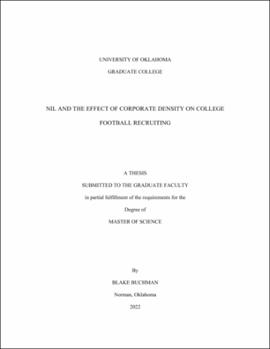| dc.contributor.advisor | Larson, Daniel | |
| dc.contributor.author | Buchman, Blake | |
| dc.date.accessioned | 2022-05-06T19:25:54Z | |
| dc.date.available | 2022-05-06T19:25:54Z | |
| dc.date.issued | 2022-05-13 | |
| dc.identifier.uri | https://hdl.handle.net/11244/335584 | |
| dc.description.abstract | College athletics is an ever-changing landscape and the most recent event to change that landscape is the introduction of Name, Image and Likeness (NIL) policies. This issue of NIL pertains to the ability for college student athletes to be paid based on commercial uses of their identity and marks the first time in over 70 years that college athletes can be compensated outside of the form of a scholarship. NIL is affecting all levels of college athletics both on and off the field. Two areas that new NIL regulations may have a large impact on are recruiting and sales of corporate sponsorships by the athletic programs. College athletes generally want to be fairly compensated for their sport performances, so naturally the athletes potentially want to attend a school that gives them the best chance to make the most money possible. As such, the athletic programs that can provide the best opportunities for income should see an improvement in recruiting and therefore should see an improvement in on field success. Off the field, NIL could lead to athletic programs receiving less money in corporate sponsorship revenue if businesses decide to give money straight to the players as opposed to the program itself. In both cases, the corporate environment could impact the opportunities available to prospective student athletes, i.e. areas with more opportunities for corporate sponsorship would be expected to have an advantage in recruiting, and more sponsoring/endorsement activities may be redirected to top student athletes. This study empirically tested the former and discusses the theory related to the expected effects on the latter. NIL changes may cause major changes in collegiate athletics and athletic programs could gain an advantage over opponents if NIL is utilized properly. The study found that there is evidence of NIL interacting with change in recruiting rankings. | en_US |
| dc.language | en_US | en_US |
| dc.subject | NIL | en_US |
| dc.subject | Recruiting | en_US |
| dc.subject | Collegiate Athletics | en_US |
| dc.subject | Corporate Sponsorships | en_US |
| dc.title | NIL and the Effect of Corporate Density on College Football Recruiting | en_US |
| dc.contributor.committeeMember | Ransom, Tyler | |
| dc.contributor.committeeMember | Black, Christopher | |
| dc.date.manuscript | 2022-05-02 | |
| dc.thesis.degree | Master of Science | en_US |
| ou.group | Dodge Family College of Arts and Sciences::Department of Health and Exercise Science | en_US |
